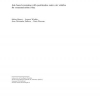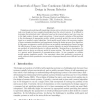SWARM
2008
SPRINGER
14 years 2 months ago
2008
SPRINGER
SWARM
2008
SPRINGER
14 years 2 months ago
2008
SPRINGER
SWARM
2008
SPRINGER
14 years 2 months ago
2008
SPRINGER
SWARM
2008
SPRINGER
14 years 2 months ago
2008
SPRINGER
Abstract Stage is a C++ software library that simulates multiple mobile robots. Stage version 2, as the simulation backend for the Player/Stage system, may be the most commonly use...
SWARM
2008
SPRINGER
14 years 2 months ago
2008
SPRINGER
In this paper, we study self-organized flocking in a swarm of mobile robots. We present Kobot, a mobile robot platform developed specifically for swarm robotic studies. We describe...
SWARM
2008
SPRINGER
14 years 2 months ago
2008
SPRINGER
We present a biologically inspired approach to the dynamic assignment and reassignment of a homogeneous swarm of robots to multiple locations, which is relevant to applications lik...
SWARM
2008
SPRINGER
14 years 2 months ago
2008
SPRINGER
Designing and analyzing self-organizing systems such as robotic swarms is a challenging task even though we have complete knowledge about the robot's interior. It is difficul...
SWARM
2008
SPRINGER
14 years 2 months ago
2008
SPRINGER
We present two swarm intelligence control mechanisms used for distributed robot path formation. In the first, the robots form linear chains. We study three variants of robot chains...





